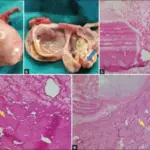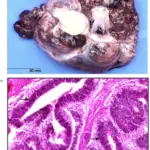Mature teratomas also called as dermatoid cysts, are a type of germ cell tumor that is usually made up of several different types of tissue, such as hair, muscle, and bone and have ability to make enzymes or hormones that may cause signs and symptoms of disease. They are benign and usually occur in the sacrum or tailbone in newborns or in the testicles or ovaries at the start of puberty.
What is the Pathology of Mature Teratomas?
The pathology of mature teratomas is:
-Etiology: The cause of mature teratomas is complications in the cell differentiation and specialization processes.
-Genes involved: PTEN gene.
-Pathogenesis: The sequence of events that lead to mature teratomas are: single germ cell after the first meiotic division develops into teratoma and matured.
-Morphology: The morphology associated with mature teratomas shows unilocular, sebaceous material.
-Histology: The histology associated with mature teratomas shows raised protuberance projecting into the cyst cavity.
How does Mature Teratomas Present?
Patients with mature teratomas typically females of younger age group till 30 years. The symptoms, features, and clinical findings associated with mature teratomas include abdominal pain, mass or swelling, and abnormal uterine bleeding, back pain, gastrointestinal disturbances.
How is Mature Teratomas Diagnosed?
Mature teratomas is diagnosed by ultrasonography, MRI, CT scan, and biopsy.
How is Mature Teratomas Treated?
Mature teratomas is treated by removal by laparoscopic surgery, oophorectomy, and cystectomy.
What is the Prognosis of Mature Teratomas?
The prognosis of mature teratomas is good.



